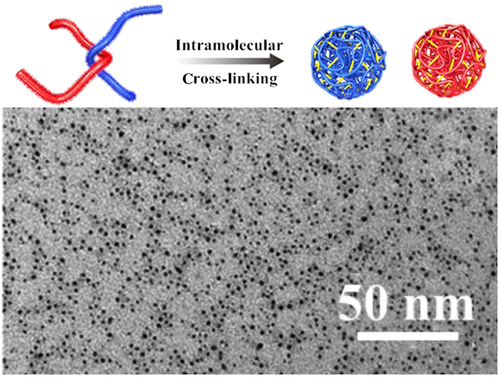Our official English website, www.x-mol.net, welcomes your
feedback! (Note: you will need to create a separate account there.)
Electrostatic-Mediated Intramolecular Cross-Linking Polymers in Concentrated Solutions
CCS Chemistry ( IF 9.4 ) Pub Date : 2019-09-24 , DOI: 10.31635/ccschem.019.20190035 Dao Xiang 1, 2 , Xi Chen 1, 2 , Lin Tang 1, 2 , Bingyin Jiang 1 , Zhenzhong Yang 1, 2, 3
CCS Chemistry ( IF 9.4 ) Pub Date : 2019-09-24 , DOI: 10.31635/ccschem.019.20190035 Dao Xiang 1, 2 , Xi Chen 1, 2 , Lin Tang 1, 2 , Bingyin Jiang 1 , Zhenzhong Yang 1, 2, 3
Affiliation

|
cross-linking of isolated single-polymer chains in
dilute solutions, the method has been extensively
employed to achieve single-chain colloids and
tadpole colloids (Janus ones) from homopolymers
and copolymers, respectively. After understanding
that the conventional fabrication methods were
based only on short-ranged protections, it has
become an urgent requirement to develop new conceptual general methods toward the intramolecular
cross-linking in concentrated solutions to determine
the improvement of stability. Thus we immediately
proposed that if long-ranged, electrostatic-mediated
intramolecular cross-linking of polymers could be
achieved in concentrated solutions, it would benefit
the establishment of more stable supermicelle
aggregates. We thought it wise to employ previously
developed electrostatic repulsion technique via
modification with monovalence agents and performed
sequential cross-linking with multiple-valence agents.
For the fabrication of polyvinylpyridine-contained
polymers, iodoethane and 1,5-diiodopentane were
used as a modification agent and a cross-linker. For
the polyacrylic-acid-contained polymers, 1-methylimidazole and 1,6-hexanediisothiocyanate were used
for the intramolecular cross-linking. Polyisoprenecontained polymers were chosen because they were
cheap. After click reaction with mercaptoacetic acid,
the fabricated polymers resembled polyacrylic-acidcontained polymers. Intramolecular cross-linking of
polystyrene-block-poly(4-vinylpyridine)-block-poly
(ethylene oxide) (PS-b-P4VP-b-PEO) was achieved
at 300 mg/mL. We found that the composition and
performance of the colloidal domains were broadly
tunable by favorable growth of functional materials,
unveiling new perspectives for deriving a huge family
of functional composite Janus colloidal single chains.
中文翻译:

浓溶液中静电介导的分子内交联聚合物
分离的单聚合物链在稀溶液中发生交联,该方法已被广泛采用,分别从均聚物和共聚物中获得单链胶体和t胶体(Janus胶体)。在了解到传统的制造方法仅基于短距离保护后,迫切需要开发一种新的概念性通用方法,以解决浓缩溶液中分子内交联的问题。因此,我们立即提出,如果可以在浓缩溶液中实现聚合物的长程静电介导的分子内交联,则将有利于建立更稳定的超胶束聚集体。我们认为明智的做法是使用以前开发的静电排斥技术,通过单价试剂进行改性,并与多价试剂进行顺序交联。为了制造含聚乙烯基吡啶的聚合物,使用碘乙烷和1,5-二碘戊烷作为改性剂和交联剂。对于含聚丙烯酸的聚合物,将1-甲基咪唑和1,6-己二异硫氰酸酯用于分子内交联。选择含聚异戊二烯的聚合物是因为它们很便宜。与巯基乙酸发生点击反应后,制成的聚合物类似于含聚丙烯酸的聚合物。聚苯乙烯-嵌段-聚(4-乙烯基吡啶)-嵌段-聚(环氧乙烷)(PS-b-P4VP-b-PEO)的分子内交联达到300 mg / mL。
更新日期:2020-06-24
中文翻译:

浓溶液中静电介导的分子内交联聚合物
分离的单聚合物链在稀溶液中发生交联,该方法已被广泛采用,分别从均聚物和共聚物中获得单链胶体和t胶体(Janus胶体)。在了解到传统的制造方法仅基于短距离保护后,迫切需要开发一种新的概念性通用方法,以解决浓缩溶液中分子内交联的问题。因此,我们立即提出,如果可以在浓缩溶液中实现聚合物的长程静电介导的分子内交联,则将有利于建立更稳定的超胶束聚集体。我们认为明智的做法是使用以前开发的静电排斥技术,通过单价试剂进行改性,并与多价试剂进行顺序交联。为了制造含聚乙烯基吡啶的聚合物,使用碘乙烷和1,5-二碘戊烷作为改性剂和交联剂。对于含聚丙烯酸的聚合物,将1-甲基咪唑和1,6-己二异硫氰酸酯用于分子内交联。选择含聚异戊二烯的聚合物是因为它们很便宜。与巯基乙酸发生点击反应后,制成的聚合物类似于含聚丙烯酸的聚合物。聚苯乙烯-嵌段-聚(4-乙烯基吡啶)-嵌段-聚(环氧乙烷)(PS-b-P4VP-b-PEO)的分子内交联达到300 mg / mL。









































 京公网安备 11010802027423号
京公网安备 11010802027423号